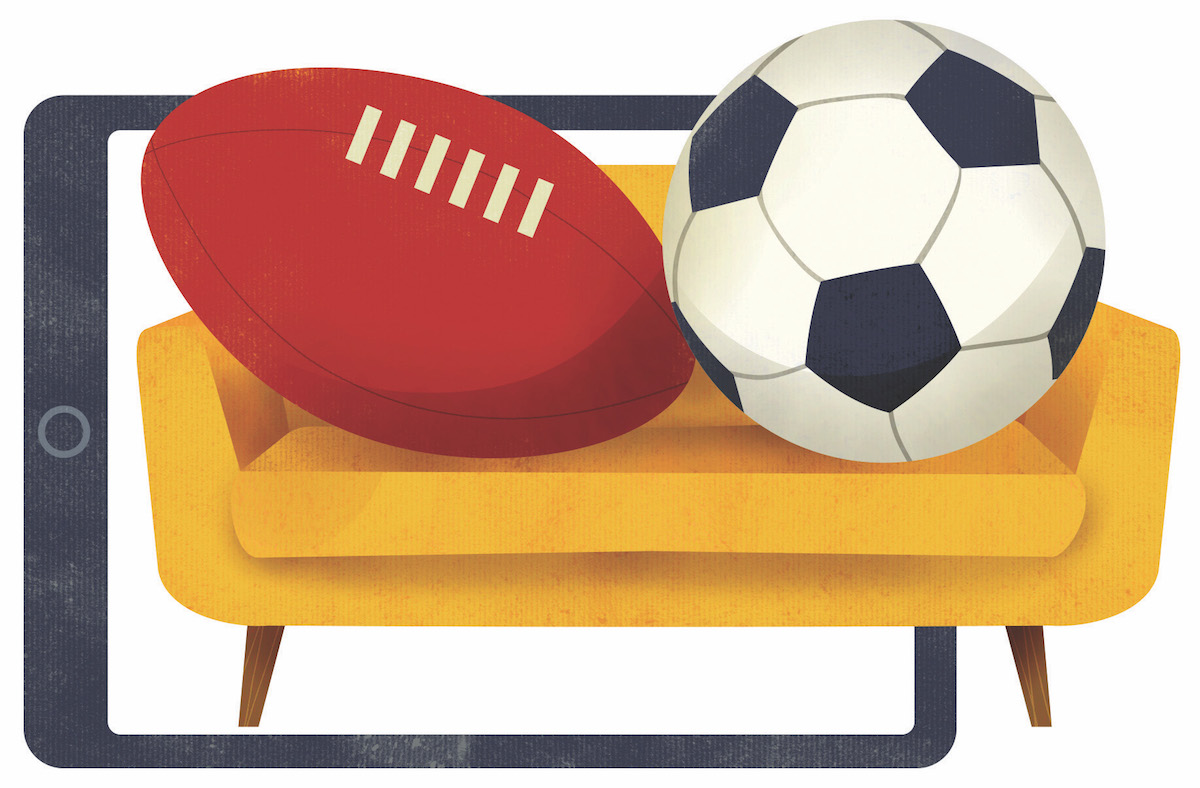A quarter of a century ago following sport was a relatively uncomplicated affair. Watch it live; catch it on TV; or listen to a broadcast on the radio — then read about the denouement in the next day’s newspaper. The key broadcast deals done back then were seemingly as modest as the consumer offerings: Channel Seven paid $100 million dollars to cover the Australian Football League (1993–98) while Kerry Packer’s Channel Nine handed over $80 million to the National Rugby League (at the time known as the Australian Rugby League) to lock up telecast of the 13-man game from 1995–2000.
These days, consumers are rather more spoilt in getting their sporting fix. Traditional viewing platforms have been augmented by everything from streaming services on laptops, phones and tablets, to podcasts and live blogs.
There are options aplenty but they come at a cost. The two biggest sporting codes in Australia both had their broadcast rights deals renewed in 2015, with the AFL ($2.508 billion; 2017–22) and NRL ($1.8 billion; 2018–22) each logging record sets of figures that almost doubled their previous arrangements. With so much money on offer it’s no wonder that sporting bodies with enough clout are considering cashing in by taking on part or all of the broadcasting themselves.
Owning the product
The concept of a sport producing coverage of its own competitions has been around for years, with the likes of the National Basketball Association (NBA) and Major League Baseball (MLB) in the US, but in Australia it’s been a little slower to take off. Seen as prohibitively expensive by some, the move requires the sport to either outsource production or have the skills in house to deliver a product on multiple platforms, and potentially to multiple stakeholders.
In 2014 Tennis Australia (TA) took this leap in a deal with Seven West Media. By keeping the production rights of the Australian Open, TA has been able to package the broadcast for particular markets and deliver key messages about its sport through its own coverage. By all accounts it has been a shrewd move.
Sold separately in a broadcast deal to Network Ten in 2013, Cricket’s Big Bash League was picked up for $100 million. Some pundits say this figure will triple for 2018–22.
As early as 2011 the AFL’s then-boss, Andrew Demetriou, spoke of “selling direct to the consumer” for the ensuing rights deals for the code. That hasn’t happened yet but with its own production house and news website — the latter the most popular sports site by visits in the country — it seems like a logical step for the AFL.
For Cricket Australia (CA) the idea is something it is considering closely as its new 2018 rights deal approaches. While pleased with the exposure gained via its premium products from Nine Network and Network Ten (test cricket, one-day internationals and the Big Bash League), Ben Amarfio, CA’s Executive General Manager – Media, Communications and Marketing, admits they “can’t satisfy our total broadcasting needs”. With cricket all but a year-round proposition these days, CA is looking for more extensive broadcasting of the state and women’s game.

“The opportunity is there for us to fill that void, even if it’s only via streaming,” says Ben. He also cites the ability to customise content for overseas markets, in much the way Tennis Australia does. “There are many economic and strategic reasons why host broadcasting may make sense and it’s something that we have to look at.”
Economies of scale seem to make this the best fit for the biggest sporting bodies in Australia, but smaller players are ready and willing to have a crack too.
In 2016 the National Basketball League (NBL) started selling its matches through the streaming service ‘NBL TV’. It offers unlimited access to all live games and a cache of other older fixtures for just $5 a month in a bid to get greater exposure for the sport. Yet, as if to prove how splintered the field is, Netball Australia has gone in the other direction. The peak body had covered the costs of television production of the defunct ANZ Championship through sponsorships; but, with a new competition for 2017 and soaring interest in the sport, it subsequently stitched up a five-year broadcast rights and revenue-sharing agreement with Nine Entertainment. The deal brings the sport to prime time free-to-air television and has ensured average player pay rises of almost 70%.
TV ain’t dead yet
While they are small relative to overall broadcast deals, digital rights for streaming have been central to recent contracts in the space (Telstra for instance paid about $300 million in the recent AFL deal to broadcast matches over its Telstra TV service, and to handsets and digital devices). As the streaming technology improves, this part of the pie is expected to grow accordingly. But those predicting the death of sport on traditional TV may have to wait awhile yet.
“Commentators have been far too quick in talking down TV and talking up the swing to digital channels,” says Ben. “TV is still overwhelmingly the most effective medium for aggregating large audiences. Major live sport and the marquee reality shows dominate when it comes to attracting large viewing audiences.
“Commentators have been far too quick in talking down TV and talking up the swing to digital channels. TV is still overwhelmingly the most effective medium for aggregating large audiences.” – Ben Amarfio, Executive General Manager – Media, Communications and Marketing at Cricket Australia
Just look at the ratings of our day/night test match last year (3 million), our T20 internationals (regularly 1.6 million) and the recent AFL and NRL grand finals and the State of Origin series. Nowhere online will you see anything approaching these types
of numbers.”
The current state of technology too plays its part, particularly for the main sports in Australia. While there’s the modified National Broadband Network still being rolled out, and increased internet speeds with it, Australia had dropped to sixtieth in the world for average peak connection speeds by the end of 2015, according to online content delivery specialist Akamai. In theory, even the average (non-peak) connection speed of 7.8MB/s here should be enough to stream a live sport event in high definition; but the reality for a top-drawer event, such as rugby league’s State of Origin, would currently be rather different according to Colin Smith, Director at Global Sports, a specialist sponsorship and media rights company. “If you had three or four million people at the same time trying to stream then technically that would fall over,” he says.

Channel Seven trumpeted a free and subscription-based stream for the 2016 Rio Olympic Games but social media was bombarded with complaints about slow download speeds and technical errors. Still, Foad Fadaghi, Managing Director of technology research firm Telsyte, believes the day is not far away where a mass-streamed sporting event would work in Australia.
“Networks are definitely working towards being able to distribute mass content simultaneously,” he says. “We saw it with the Olympics — there was a large spike in data during, say, the Olympic 100m final. Telstra claimed the network was only at quarter capacity. Broadcasting on a mass scale is being looked at … we are close if not already there.”
New stakeholders, new ground
Until recently the fundamental broadcast space for sports in Australia had been controlled by the more traditional stakeholders of free-to-air and pay television. Then Optus broke the nexus.
In a move that raised many an eyebrow, the telco slipped under the guard of Foxtel to snare Australian rights for the English Premier League (EPL) in a three-year deal worth an estimated $200 million. With a blind auction for the rights, Foxtel didn’t see what was coming and it was thought to have been outbid by more than $100 million.
While there’s been a mixed response to Optus’ EPL packages and service provision since it launched in August 2016 — complaints have centred on tying viewership in with either having Optus internet/mobile services, and there’s been some technical issues with the coverage — it is clearly just the first shot across the bow from the telco, and presumably other non-traditional sports-rights holders. With the A-League requiring a new broadcast deal by mid 2017 (it’s expected to be finalised by early in the year), Optus may yet throw its hat in the ring to claim another piece of round-ball action. Then there’s reason to think other players such as Google, YouTube (which broadcast Indian cricket’s 2010 Premier League) and even Facebook or media streaming company Netflix might stump up for Australian sports in the future.
I fought the law
Australia’s anti-siphoning laws limit what both pay television networks and streaming services can own and show. Some of the tightest in the world, they include an extensive list of sporting events that must be offered for free in the first instance, such as the Olympics, AFL, rugby league and domestic cricket tests.
While the assumption is that ‘free’ means free-to-air television, Colin raises a fascinating and very modern conundrum: if an online service provider streamed a sporting event on the anti-siphoning list for free — assuming it could raise enough revenue from advertising and elsewhere — would that meet the requirements under the Broadcasting Services Act?
“If I stream and it is free — is that actually regarded as a free service?” he asks. “One school of thought says it is. Another says, because you have to pay for the streaming service and they have limits on them, then that is not free.
It will be an interesting one going forward. I’d say the pollies are going to be in a muddle with that one, and at some stage someone will push it.”
No such thing as a free sport
With so much at stake it’s inevitable that there’ll be winners and losers. Consumers who had been shackled by the bundling of services from Foxtel discovered that the grass wasn’t necessarily greener after Optus roped in customers to enjoy the EPL via their internet and mobile packages. But recent history has also shown that digital disruptors (think Netflix) can provide different models at more competitive prices that will invariably keep the more established players honest.
“I don’t think a lot of it will come down to the delivery mechanism but more so the level of quality and the strength of the sportspeople who are competing on a global scale. That will generate the most amount of interest and viewership.” – Foad Fadaghi, Managing Director of Telsyte
Ultimately, lovers of the game should finish in front. “Sports fans will hopefully get more choices with what they want to watch, when they want to watch and where they want to watch it,” says Merryn Sherwood, lecturer in sports journalism at La Trobe University. “If the technology catches up there should be almost unlimited options as to the sport you can watch every day.”
As for the different sporting codes themselves, it could prove a bit of a mixed bag. “At the moment you have the dominance of the NRL, the AFL and cricket. The two losers at the moment are rugby and football (A-League),” says Colin, who adds that a good pay TV deal for Super Rugby in the UK was the one bright spot for a code that’s struggling with a muddled multi-nation competition, and for viewers in Australia. But Foad has a different take — that the real winners will ultimately sort themselves on the field of play.
“A lot of it has to do with the performance of the teams,” he says. “I don’t think a lot of it will come down to the delivery mechanism but more so the level of quality and the strength of the sportspeople who are competing on a global scale. That will generate the most amount of interest and viewership.”





